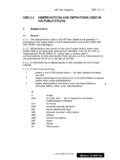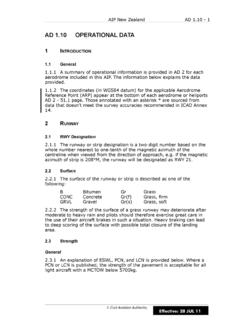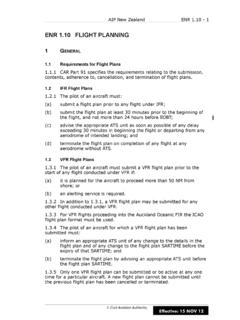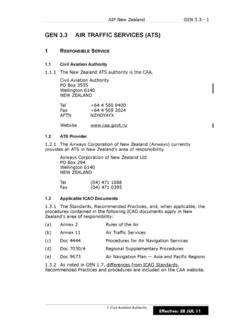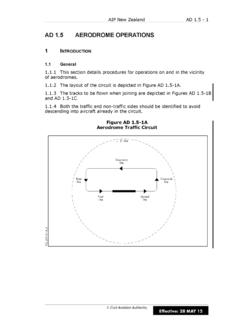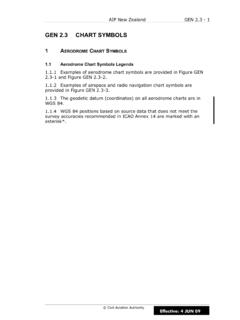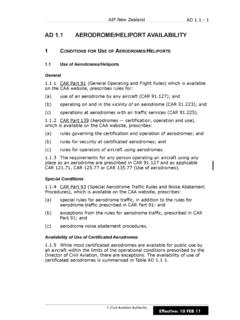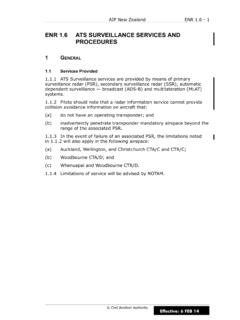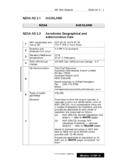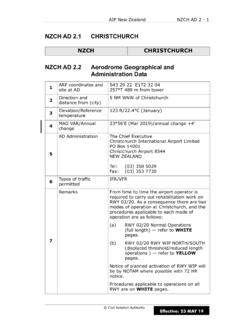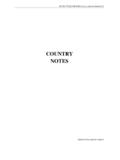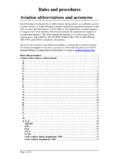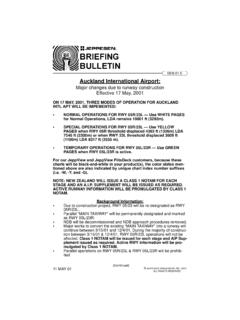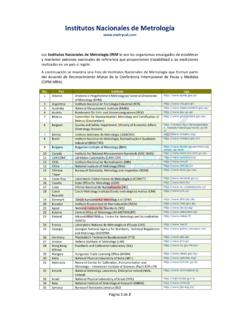Transcription of GEN 3.4 COMMUNICATION SERVICES - AIP New Zealand
1 GEN - 1 AIP New ZealandECivil Aviation AuthorityGEN COMMUNICATION Civil Aviation The CAA is required to:(a) determine the minimum level of aeronautical telecommunicationservices and the minimum number of telecommunication facilities tobe provided by New Zealand in order to ensure the safe conduct ofinternational air navigation in the region; and(b) ensure those SERVICES are provided and those facilities Civil Aviation Rules Part CAR Part 171, Aeronautical Telecommunication SERVICES Operationand Certification, prescribes:(a) Operating and technical standards for aeronauticaltelecommunications SERVICES and facilities; and(b) Rules governing the certification and operation of organisationsproviding aeronautical telecommunication SERVICES in support of IFRflights or an air traffic Service The Airways Corporation of New Zealand Limited (Airways) providesalmost all of the aeronautical COMMUNICATION SERVICES in New Zealand ,although there are two other organisations that hold CAR Part 171certificates to provide limited and specific COMMUNICATION Corporation of New Zealand LtdPO Box 294 Wellington 6140 NEW ZEALANDTel(04) 471 1888 Fax(04) 471 A small number of private radio aids and communications facilities( operated by organisations other than Airways) may also be operatingaround New Zealand at any.
2 29 MAR 18 GEN - 2 AIP New ZealandECivil Aviation Applicable ICAO The ICAO Standards, Recommended Practices, and, whenapplicable, the procedures contained in the following ICAO documentsapply in New Zealand s area of responsibility:(a) Annex 10 Aeronautical Telecommunications(b) Doc 7030 Regional Supplementary Procedures, Part 3(c) Doc 7910 Location Indicators(d) Doc 8400 ICAO Abbreviations and Codes(e) Doc 8585 Designators for Aircraft Operating Agencies,(f) Aeronautical Authorities and As noted in GEN , differences from ICAO Standards,Recommended Practices and Procedures are included on the CAA Hours of The hours of service of all COMMUNICATION SERVICES associated withATS are the ATS hours of operation as published in SUP and amended byNOTAM.
3 All other COMMUNICATION SERVICES are H24 unless specifically notedin the ENR or AD parts of this : 4 SEP 03 GEN - 3 AIP New ZealandECivil Aviation Authority2 AREA New Zealand Airways provides COMMUNICATION SERVICES throughout the NewZealand FIR (NZZC). Auckland Oceanic Airways provides ATS throughout the Auckland Oceanic FIR (NZZO),exceptintheCook,McMurdo,Samoa,and Tongasectors, Responsibility for the provision of COMMUNICATION SERVICES within theCook Sector of NZZO is vested in the Rarotonga ATS Information regarding COMMUNICATION SERVICES in the Cook Sector iscontained in the AIP Cook Islands, and depicted on the Auckland OceanicEnroute COMMUNICATION SERVICES within the McMurdo Sector (when thesector is activated) are provided by the US Navy facility at McMurdo, toaircraft supporting the US Antarctic Information regarding COMMUNICATION SERVICES in the McMurdoSector is contained in the relevant US aeronautical.
4 20 SEP 12 GEN - 4 AIP New ZealandECivil Aviation AuthoritySamoa Responsibility for the provision of COMMUNICATION SERVICES within theSamoa Sector of the Auckland Oceanic FIR is vested in the Faleolo Information regarding COMMUNICATION SERVICES in the Samoa Sectoris contained in the AIP Samoa, and depicted on the Auckland OceanicEnroute Responsibility for the provision of COMMUNICATION SERVICES within theTonga Sector of the Auckland Oceanic FIR is vested in the Fua amotu Information regarding COMMUNICATION SERVICES in the Tonga Sectoris contained in the AIP Tonga, and depicted on the Auckland OceanicEnroute Norfolk Island is contained within NZZO and administered For COMMUNICATION SERVICES within the Norfolk Island MBZ refer tothe Australian : 16 FEB 06 GEN - 5 AIP New ZealandECivil Aviation Authority3 TYPES Radio Navigation The following types of radio aids to navigation operate within theNew Zealand FIR and Auckland Oceanic FIR:(a) MF Non-Directional Beacons (NDB)(b) Marine Radio Beacons(c) VHF Direction-Finding Stations (VDF)(d) VHF Omni-Directional Radio Range (VOR)(e) Distance Measuring Equipment (DME)(f) Instrument Landing System (ILS) Also operating within the New Zealand FIR are.
5 (a) Primary Surveillance Radar (PSR)(b) Secondary Surveillance Radar (SSR)(c) Automatic dependent surveillance broadcast (ADS-B)(d) Multilateration (MLAT)MF Non-Directional Beacons (NDB) There are a limited number of MF frequencies available in NewZealand, and the same frequency may be allocated to two or morebeacons. Where this occurs, such beacons are widely spaced geographicallyto minimise any mutual The rated coverage of an NDB provides a radial distance from thebeacon within which usable guidance may be obtained under normalconditions. Rated coverage and known limitations are listed in Table Variations in rated coverage resulting from changes in propagation,atmospheric noise, and night effect will Night effect may substantially reduce the coverage of an NDB as aresult of interference between the ground waves, (received by direct path)and the sky waves (received after being reflected off the ionosphere).
6 Effective: 29 MAR 18 DGEN - 6 AIP New ZealandECivil Aviation AuthorityMarine Radio :Marine radio beacons should not to be used for primaryaeronautical New Zealand maritime authorities maintain two marine radiobeacons (NDBs), for ships MF DF calibration purposes, at Mokohinau Islandand Dog Island. The beacons and other marine NDBs around NewZealandthatarebeingphasedout areshownonsomeaeronauticalcharts but they should not be used as a primary means of The beacons are not subject to flight or ground inspection byaeronautical authorities and NOTAM will not be issued concerning Broadcast stations are not authorised for use in IFR Direction-Finding Stations (VDF) VDF is available at selected control towers. It operates on a towerfrequency and indicates the magnetic bearing of the transmitter from thetower.
7 Controllers may use VDF to assist in sighting aircraft in the vicinityof the VDF can be used in an emergency on request to providenavigational assistance; however, the equipment is not calibrated andacceptance of given information is at the pilot s Omni-Directional Radio Range (VOR) VOR operate in the frequency band 112 118 MHz. VOR radials aredesignated by the magnetic bearing of the radial from the station to theaircraft. Thus the 090 radial lies east of the : 2 SEP 04 GEN - 7 AIP New ZealandECivil Aviation AuthorityDistance Measuring Equipment (DME) DME operate in the frequency band 962 1213 MHz. DME channelsare paired with VOR frequencies. Many airborne installations require theVOR frequency to be selected in order to select the DME.
8 The FREQ orCHANNEL listing in Table GEN shows the paired VOR frequency, evenfor locations where only a DME is Where installed, DME channels are also paired with LOC DME channels are also paired with VORTAC Brief erroneous indications, caused by shading of the signal belowIFR altitudes or by the complex processing used in some airborneequipment, can occur. DME distance indications should be clear andunambiguous for at least 15 seconds before being used for Landing System (ILS) ILS localisers (LOC) operate in the frequency band 108 112 coverage is not provided outside the sector of 35 degrees eitherside of the front course Where installed, DME are paired with the ILS glide path equipment operates in the frequency band MHz. The glide path frequency is paired with the LOC ILS Markers operate on a frequency of 75 Details of specific New Zealand ILS installations and knownlimitations are contained in Table GEN :The following applies to the use of ILS outside Towerhours of watch (also refer ENR IFR Arrival Procedures Unattended Aerodromes):(a) The ILS will be set to one runway only and cannot be changed byATS.
9 Approach units will be aware of which runway is selected.(b) If using a remote QNH (ENR section refers) a glide pathverification check will not be achieved to the same accuracy.(c) Protection zones for the LOC and GP elements may not be protectedfrom aircraft or vehicle intrusion which may cause coursedisturbances.(d) ATC will not be able to notify change of equipment status if theaircraft is operating on the unattended frequency for Navigation facilities are contained in Table GEN : 29 MAR 18 DGEN - 8 AIP New ZealandECivil Aviation Navigation Aid Radio navigation aids for general use are identified by a two letteridentifier, normally taken from the name of the location concerned, For ILS/Localiser and associated DME installations, the letter I precedes the two-letter Non-Airways radio aids that are restricted on operational grounds tospecific users are identified by a three-letter Mobile/Fixed ServicesMobile Mobile SERVICES are as follows.
10 (a) Air ground communications in the New Zealand FIR and AucklandOceanic FIR are conducted by radiotelephony (RTF) in the VHF, UHFand HF frequency bands. Air to air communications are conductedin the VHF band.(b) VHF is the primary frequency band for domestic operations, with HFavailable in the Southland/Fiordland area only. UHF is intendedprimarily for use with military aircraft. At some locations,re-transmission facilities are provided to link two or more VHFand/or UHF channels together or to remote the service to anotherATS unit.(c) Radio communications facilities and frequencies are provided inGEN , and on charts.(d) All ATS units are equipped with automatic recording facilities thatrecord all communications to and from each ATS unit, irrespective ofthe medium A diagrammatic representation of the ATS speech circuits isprovided in Figure GEN : 29 MAR 18 GEN - 9 AIP New ZealandECivil Aviation AuthorityFlight Information Service Communications (FISCOM) FISCOM charts for the North Island and South Island are shown inFigures GEN and GEN respectively.
